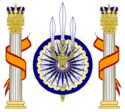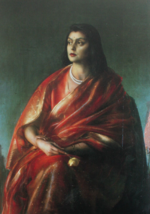Premier of Rajyaghar: Difference between revisions
(Changed Prime Minister to Premier and updated list of Premiers) |
m (→List of Premiers: added royal portraits) |
||
| Line 96: | Line 96: | ||
==List of Premiers== | ==List of Premiers== | ||
===Premiers under Krishan VI=== | ===Premiers under Krishan VI=== | ||
[[File: Ganga Singh c1930.jpg|150px|right|thumb|Maharaja [[Krishan VI]]]] | |||
{| class="wikitable" style="line-height:1.4em; text-align:center" | {| class="wikitable" style="line-height:1.4em; text-align:center" | ||
! colspan="2" scope="col" | Portrait | ! colspan="2" scope="col" | Portrait | ||
| Line 137: | Line 138: | ||
===Premiers under Rajaram V=== | ===Premiers under Rajaram V=== | ||
[[File: Shri Sir Nripendra Narayan, Maharaja of Cooch Behar.jpg|150px|right|thumb|Maharaja [[Rajaram V]]]] | |||
{| class="wikitable" style="line-height:1.4em; text-align:center" | {| class="wikitable" style="line-height:1.4em; text-align:center" | ||
! colspan="2" scope="col" | Portrait | ! colspan="2" scope="col" | Portrait | ||
| Line 146: | Line 148: | ||
| rowspan=1 style="background: #FFA500;" | 4 | | rowspan=1 style="background: #FFA500;" | 4 | ||
| rowspan=1|[[File:Rajiv Gandhi (1987).jpg|100px]] | | rowspan=1|[[File:Rajiv Gandhi (1987).jpg|100px]] | ||
| rowspan=1| | | rowspan=1|Abhinav Devdhar Malhotra | ||
| 1961 - 1964<br>(3 years) | | 1961 - 1964<br>(3 years) | ||
| | | Malhotra Premiership<br><small>5th Rajyani Ministry</small> | ||
| rowspan=1|''1960'' | | rowspan=1|''1960'' | ||
| rowspan=1|''Majority Government'' | | rowspan=1|''Majority Government'' | ||
| Line 154: | Line 156: | ||
===Premiers under Shakti III=== | ===Premiers under Shakti III=== | ||
[[File: Shakti III.png|150px|right|thumb|Maharani [[Shakti III]]]] | |||
{| class="wikitable" style="line-height:1.4em; text-align:center" | {| class="wikitable" style="line-height:1.4em; text-align:center" | ||
! colspan="2" scope="col" | Portrait | ! colspan="2" scope="col" | Portrait | ||
| Line 163: | Line 166: | ||
| rowspan=1 style="background: #FFA500;" | 4 | | rowspan=1 style="background: #FFA500;" | 4 | ||
| rowspan=1|[[File:Rajiv Gandhi (1987).jpg|100px]] | | rowspan=1|[[File:Rajiv Gandhi (1987).jpg|100px]] | ||
| rowspan=1| | | rowspan=1|Abhinav Devdhar Malhotra | ||
| 1964 - 1967<br>(3 years) | | 1964 - 1967<br>(3 years) | ||
| | | Malhotra Premiership<br><small>5th & 6th Rajyani Ministries</small> | ||
| rowspan=1|1965 | | rowspan=1|1965 | ||
| rowspan=1|Majority Government | | rowspan=1|Majority Government | ||
| Line 171: | Line 174: | ||
| rowspan=1 style="background: #FFA500;" | 5 | | rowspan=1 style="background: #FFA500;" | 5 | ||
| rowspan=1|[[File:Rajyanipersontemplate.png|100px]] | | rowspan=1|[[File:Rajyanipersontemplate.png|100px]] | ||
| rowspan=1|[[ | | rowspan=1|[[Anil Bhattacharya]] | ||
| 1967 - 1968<br>(>1 year) | | 1967 - 1968<br>(>1 year) | ||
| [[ | | [[Bhattacharya Premiership]]<br><small>7th Rajyani Ministry</small> | ||
| rowspan=1|-- | | rowspan=1|-- | ||
| rowspan=1|{{wp|National Unity Government}} | | rowspan=1|{{wp|National Unity Government}} | ||
| Line 180: | Line 183: | ||
| rowspan=1|[[File:Rajyanipersontemplate.png|100px]] | | rowspan=1|[[File:Rajyanipersontemplate.png|100px]] | ||
| rowspan=1|[[XX]] | | rowspan=1|[[XX]] | ||
| 1968 - | | 1968 - 1978<br>(10 years) | ||
| [[XX Premiership]]<br><small>8th Rajyani Ministry</small> | | [[XX Premiership]]<br><small>8th & 9th Rajyani Ministries</small> | ||
| rowspan=1| | | rowspan=1|1968<br>1973 | ||
| rowspan=1|Majority Government<br>Majority Government | |||
|- | |||
| rowspan=1 style="background: #BF0505;" | 7 | |||
| rowspan=1|[[File:Rajyanipersontemplate.png|100px]] | |||
| rowspan=1|[[XX]] | |||
| 1978 - 1980<br>(2 years) | |||
| [[XX Premiership]]<br><small>10th Rajyani Ministry</small> | |||
| rowspan=1|1978 | |||
| rowspan=1|Majority Government | | rowspan=1|Majority Government | ||
|- | |||
| rowspan=1 style="background: #FFA500;" | 8 | |||
| rowspan=1|[[File:Rajyanipersontemplate.png|100px]] | |||
| rowspan=1|[[Karan Kagalwala]] | |||
| 1980 - 1984<br>(4 years) | |||
| [[Kagalwala Premiership]]<br><small>11th Rajyani Ministry</small> | |||
| rowspan=1|1980 | |||
| rowspan=1|Majority Government | |||
|} | |||
===Premiers under Krishan VII=== | |||
[[File: KrishanVII.jpg|150px|right|thumb|Maharaja [[Krishan VII]]]] | |||
{| class="wikitable" style="line-height:1.4em; text-align:center" | |||
! colspan="2" scope="col" | Portrait | |||
! colspan="1" scope="col" | Name | |||
! colspan="1" scope="col" | Term of office | |||
! colspan="1" scope="col" | Government | |||
! colspan="2" scope="col" | Elections & Mandates | |||
|- | |||
| rowspan=1 style="background: #FFA500;" | 8 | |||
| rowspan=1|[[File:Rajyanipersontemplate.png|100px]] | |||
| rowspan=1|Karan Kagalwala | |||
| 1984 - 1985<br>(1 year) | |||
| Kagalwala Premiership<br><small>11th Rajyani Ministry</small> | |||
| rowspan=1|''1980'' | |||
| rowspan=1|''Majority Government'' | |||
|- | |||
| rowspan=1 style="background: #BF0505;" | 9 | |||
| rowspan=1|[[File:Rajyanipersontemplate.png|100px]] | |||
| rowspan=1|[[XX]] | |||
| 1985 - 1988<br>(3 years) | |||
| [[XX Premiership]]<br><small>12th & 13th Rajyani Ministries</small> | |||
| rowspan=1|1985<br>1987 | |||
| rowspan=1|Majority Government<br>{{wp|Coalition Government}} | |||
|- | |||
| rowspan=1 style="background: #FFA500;" | 10 | |||
| rowspan=1|[[File:Vasundhra Raje.jpg|100px]] | |||
| rowspan=1|[[Kalyani Bajpeyi]] | |||
| 1988 - 1995<br>(7 years) | |||
| [[Bajpeyi Premiership]]<br><small>14th & 15th Rajyani Ministries</small> | |||
| rowspan=1|1988<br>1992 | |||
| rowspan=1|Majority Government<br>Majority Government | |||
|- | |||
| rowspan=1 style="background: #BF0505;" | 11 | |||
| rowspan=1|[[File:Rajyanipersontemplate.png|100px]] | |||
| rowspan=1|[[XX]] | |||
| 1995 - 2000<br>(5 years) | |||
| [[XX Premiership]]<br><small>16th Rajyani Ministry</small> | |||
| rowspan=1|1995 | |||
| rowspan=1|Majority Government | |||
|- | |||
| rowspan=1 style="background: #BF0505;" | 12 | |||
| rowspan=1|[[File:Rajyanipersontemplate.png|100px]] | |||
| rowspan=1|[[XX]] | |||
| 2000 - 2010<br>(10 years) | |||
| [[XX Premiership]]<br><small>17th & 18th Rajyani Ministries</small> | |||
| rowspan=1|2000<br>2005 | |||
| rowspan=1|Majority Government<br>Majority Government | |||
|- | |||
| rowspan=1 style="background: #FFA500;" | 13 | |||
| rowspan=1|[[File:PM Modi Portrait(cropped).jpg|100px]] | |||
| rowspan=1|[[Madhava Thakur]] | |||
| 2010 - ''incumbent''<br>(11 years) | |||
| [[Thakur Premiership]]<br><small>19th, 20th & 21st Rajyani Ministries</small> | |||
| rowspan=1|2010<br>2015<br>2020 | |||
| rowspan=1|Coalition Government<br>Majority Government<br>Majority Government | |||
|} | |} | ||
==Living former Premiers== | |||
{{Rajyaghar}} | {{Rajyaghar}} | ||
Revision as of 20:21, 16 March 2021
This article is incomplete because it is pending further input from participants, or it is a work-in-progress by one author. Please comment on this article's talk page to share your input, comments and questions. Note: To contribute to this article, you may need to seek help from the author(s) of this page. |
| Premier of Rajyaghar | |
|---|---|
| राजाघर का प्रधान मंत्री | |
 Government Seal | |
| Central Union Government Premier's Office | |
| Style | The Right Honourable His Excellency (diplomatic) Mr. Premier (informal) |
| Status | Head of Government |
| Abbreviation | PM |
| Member of | Shahee Sansad, Ashta Pradhan, National Security Council |
| Reports to | Monarch of Rajyaghar, Shahee Sansad |
| Residence | The State House |
| Seat | Government Hill, Kinadica |
| Nominator | Political Parties |
| Appointer | Monarch of Rajyaghar based on appointee's ability to command confidence in the Shahee Sansad |
| Term length | At His Majesty's pleasure Shahee Sansad term is 5 years unless dissolved sooner |
| Constituting instrument | Constitution of Rajyaghar, Acts of Governance |
| Formation | October 1946 |
| First holder | Baiju Pahir Kapadia |
| Unofficial names | Peshwa |
The Premier of Rajyaghar (Matrabashi: Rajyaghār ke Pradhānamantrī) officially the Premier of the Kingdom of Rajyaghar is the leader of the Central Union Government; the executive branch of the Government of Rajyaghar. The Premier is the chief adviser to the Monarch of Rajyaghar and the head of the Ashta Pradhan (Cabinet). Whilst the Monarch may appoint any citizen to serve as Premier, by convention the Premier is appointed from amongst the sitting members of the largest political party in the Shahee Sansad.
The Premier is the most senior member of the Ashta Pradhan and is de facto chairman of the body when the Monarch does not preside over its sessions. As such, the Premier alone may nominate members of the Ashta Pradhan and can request the dismissal of Ministers to the Monarch. The Pirme Minister is also entrusted with advising the Monarch on the exercise of Royal Decrees. The Ashta Pradhan is collectively and individually responsible to the Shahee Sansad and the Premier must retain the confidence of a majority in the Shahee Sansad. Failure to secure a majority in the Shahee Sansad when instructed by the Monarch shall result in the immediate dismissal of a Premier.
The Office of Premier comes with certain privileges including a security detail, paid expenses and residency at the State House. Former Premiers are also afforded a security detail for life, access to State Guest Houses. Former Premiers are also entitled to sit and observe debates of the Shahee Sansad from within its chamber, however, they cannot vote.
The incumbent Premier is Madhava Thakur who has served as PM since September 2010. Thakur first led a coalition government between his Rajyani Rashtriya Party and the Liberal Party. Thakur and the RRP were returned to power as a majority government in 2015 and again in 2020.
Appointment, Tenure and Removal
Eligibility
In order for an individual to be appointed to the Office of Premier, they must fulfill the following criteria set out by the Constitution:
- Be a Citizen of the Kingdom of Rajyaghar,
- Have resided within the Kingdom of Rajyaghar for the last ten years,
- Be above the age of 25 years,
- Not be found guilty of a serious crime,
Appointment Process
The Constitution states that the Monarch may appoint any citizen to be Premier, provided they meet the qualifications listed above, but by convention the Monarch will appoint the leader of the largest party or political group in the Shahee Sansad. The Monarch may also dismiss Premiers at their discretion but this is reserved for emergency situations and this power has never been exercised.
Following a General Election, if a political party wins a majority of seats in the Shahee Sansad, their leader is invited by the Monarch to form a new government. If the outcome of a general election is unclear (i.e. hung parliament) the Monarch will often wait for the political parties to form coalitions before selecting an individual to serve as Premier so as to avoid any inference of political bias.
When an individual is selected to be the next Premier, they are invited to the Royal Palace where the Monarch will invite them to form a Government. The new Premier will then nominate individuals to serve in the Ashta Pradhan, as Ministers of the Crown and to fill other government posts. In an inauguration ceremony held usually that day or the following day, the Premier is given a ceremonial swearing in ceremony and his cabinet nominees are officially sworn into office.
Tenure and Removal
The Premier of the Kingdom of Rajyaghar serves at 'His Majesty's pleasure' and may therefore remain in office indefinitely, so long as the Monarch retains their confidence in them. By convention, however, a Premier must have the confidence of a majority of the Shahee Sansad as for a government to function they must be able to pass legislation through the legislature.
At the beginning of each session of the Shahee Sansad, there is a speech from the throne where the Government prepares a speech outlining their agenda for the session, which the Monarch will read before the Shahee Sansad, this is called the 'Royal Address'. Following the Royal Address, the Shahee Sansad will hold a Vote of Confidence in the Government. If the government wins the vote, the Premier is assumed to have the support of the Shahee Sansad for the duration of that session unless they lose a vote of no confidence. If the government loses the vote, the Premier must resign and the Shahee Sansad is given 2 weeks to appoint a new Premier or a new General Election is called.
Following a successful vote of no confidence the Shahee Sansad is automatically tasked with nominating a new individual to the Maharaja. This is done via a 'Premierial Ballot' in the Shahee Sansad in which any member who wishes to serve as Premier puts their name forward and a series of votes via the optional preferential voting system is used until a single candidate has 50%+1 votes in favour of their nomination. However, there is an option for not voting for a candidate which can cause this process to fail. If the process fails and 2 weeks have expired since the vote of no confidence, the Monarch must dissolve the Shahee Sansad and call for a new General Election.
Continuity of Government
Before 2013, the death or incapacity of a Premier would have left serious gaps within the national security apparatus of the Kingdom. As a result, the Thakur Government passed the Continuity of Government Act (2013) which established a clear line of succession to the duties of the Premier should they die or be incapacitated. In Rajyaghar, there is no such thing as an "acting" Premier as the Constitution does not allow for anyone or anything, including laws, to appoint the Premier except for the Monarch. As the national security apparatus is not established in the Constitution but rather via various Acts of the Shahee Sansad, the duties afforded to the Premier via these acts can be transferred to an individual in the case of incapacity or death and this is what is done through the Continuity of Government Act (2013). Additional duties such as the chairmanship of the Ashta Pradhan are also transferred as the Constitution does not bar this from occurring. The term for this process is named after the act itself; Continuity of Government.
If Continuity of Government is invoked, the order of succession for acquiring the additional duties is as follows:
- Secretary of State for Foreign Affairs
- Secretary of State for Defence
- Secretary of State for Home Affairs
- Secretary of State for the Treasury
- The Monarch of Rajyaghar
The Continuity of Government Act (2013) allows for three scenarios:
- Death of the Premier (Article 1) - If a Premier dies in office, Article 1 of the Continuity of Government Act (2013) is automatically. Since 1978, all national political parties have frameworks in place to allow for the immediate nomination of a new party leader to the Monarch which allows for a new Premier to be appointed within a matter of hours.
- Voluntary incapacity of the Premier (Article 2) - If a Premier must recuse themself from conducting the business of government, they may invoked Article 2 themself. This requires a signed, written declaration stating that they are temporarily recusing themselves from the duties safeguarded under the Continuity of Government Act (2013). When the Premier wishes to return from their recusal, they must sign another written declaration stating that they wish to resume their duties. This second letter must be presented to the Monarch after which the Premier automatically resumes their duties safeguarded under the Continuity of Government Act (2013). During their recusal, the individual remains Premier as not all duties can be transferred.
- Involuntary incapacity of the Premier (Article 3) - In the event of involuntary incapacity, a majority of the Ashta Pradhan must sign a Letter of Recommendation to the Monarch stating that Continuity of Government should be invoked. Historians have widely speculated that if the Continuity of Government Act (2013) had been in place during the Emergency of 1964-67, the Ashta Pradhan would have invoked Article 3 to remove Premier Malhotra.
Powers and Roles
Duties
Privileges
List of Premiers
Premiers under Krishan VI

| Portrait | Name | Term of office | Government | Elections & Mandates | ||
|---|---|---|---|---|---|---|
| 1 | 
|
Baiju Pahir Kapadia | 1946 - 1951 (5 years) |
Kapadia Premiership 1st Rajyani Ministry |
1946 | Majority Government |
| 2 | 
|
Anand Mahanti | 1951 - 1955 (4 years) |
Mahanti Premiership 2nd Rajyani Ministry |
1951 | Majority Government |
| 3 | 
|
Onkar Jariwala | 1955 - 1960 (5 years) |
Jariwala Premiership 3rd & 4th Rajyani Ministries |
1955 1959 |
Majority Government Minority Government |
| 4 | 
|
Abhinav Devdhar Malhotra | 1960 - 1961 (1 year) |
Malhotra Premiership 5th Rajyani Ministry |
1960 | Majority Government |
Premiers under Rajaram V

| Portrait | Name | Term of office | Government | Elections & Mandates | ||
|---|---|---|---|---|---|---|
| 4 | 
|
Abhinav Devdhar Malhotra | 1961 - 1964 (3 years) |
Malhotra Premiership 5th Rajyani Ministry |
1960 | Majority Government |
Premiers under Shakti III

| Portrait | Name | Term of office | Government | Elections & Mandates | ||
|---|---|---|---|---|---|---|
| 4 | 
|
Abhinav Devdhar Malhotra | 1964 - 1967 (3 years) |
Malhotra Premiership 5th & 6th Rajyani Ministries |
1965 | Majority Government |
| 5 | 
|
Anil Bhattacharya | 1967 - 1968 (>1 year) |
Bhattacharya Premiership 7th Rajyani Ministry |
-- | National Unity Government |
| 6 | 
|
XX | 1968 - 1978 (10 years) |
XX Premiership 8th & 9th Rajyani Ministries |
1968 1973 |
Majority Government Majority Government |
| 7 | 
|
XX | 1978 - 1980 (2 years) |
XX Premiership 10th Rajyani Ministry |
1978 | Majority Government |
| 8 | 
|
Karan Kagalwala | 1980 - 1984 (4 years) |
Kagalwala Premiership 11th Rajyani Ministry |
1980 | Majority Government |
Premiers under Krishan VII

| Portrait | Name | Term of office | Government | Elections & Mandates | ||
|---|---|---|---|---|---|---|
| 8 | 
|
Karan Kagalwala | 1984 - 1985 (1 year) |
Kagalwala Premiership 11th Rajyani Ministry |
1980 | Majority Government |
| 9 | 
|
XX | 1985 - 1988 (3 years) |
XX Premiership 12th & 13th Rajyani Ministries |
1985 1987 |
Majority Government Coalition Government |
| 10 | 
|
Kalyani Bajpeyi | 1988 - 1995 (7 years) |
Bajpeyi Premiership 14th & 15th Rajyani Ministries |
1988 1992 |
Majority Government Majority Government |
| 11 | 
|
XX | 1995 - 2000 (5 years) |
XX Premiership 16th Rajyani Ministry |
1995 | Majority Government |
| 12 | 
|
XX | 2000 - 2010 (10 years) |
XX Premiership 17th & 18th Rajyani Ministries |
2000 2005 |
Majority Government Majority Government |
| 13 | 
|
Madhava Thakur | 2010 - incumbent (11 years) |
Thakur Premiership 19th, 20th & 21st Rajyani Ministries |
2010 2015 2020 |
Coalition Government Majority Government Majority Government |

